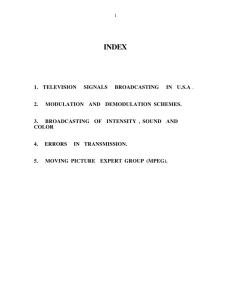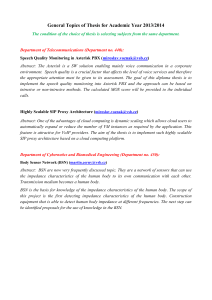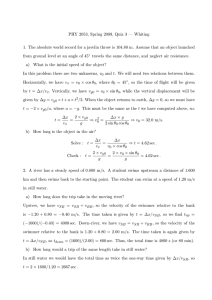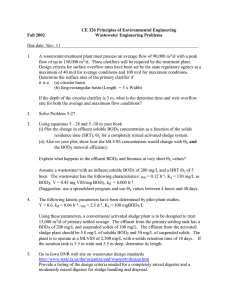Document 14081100
advertisement
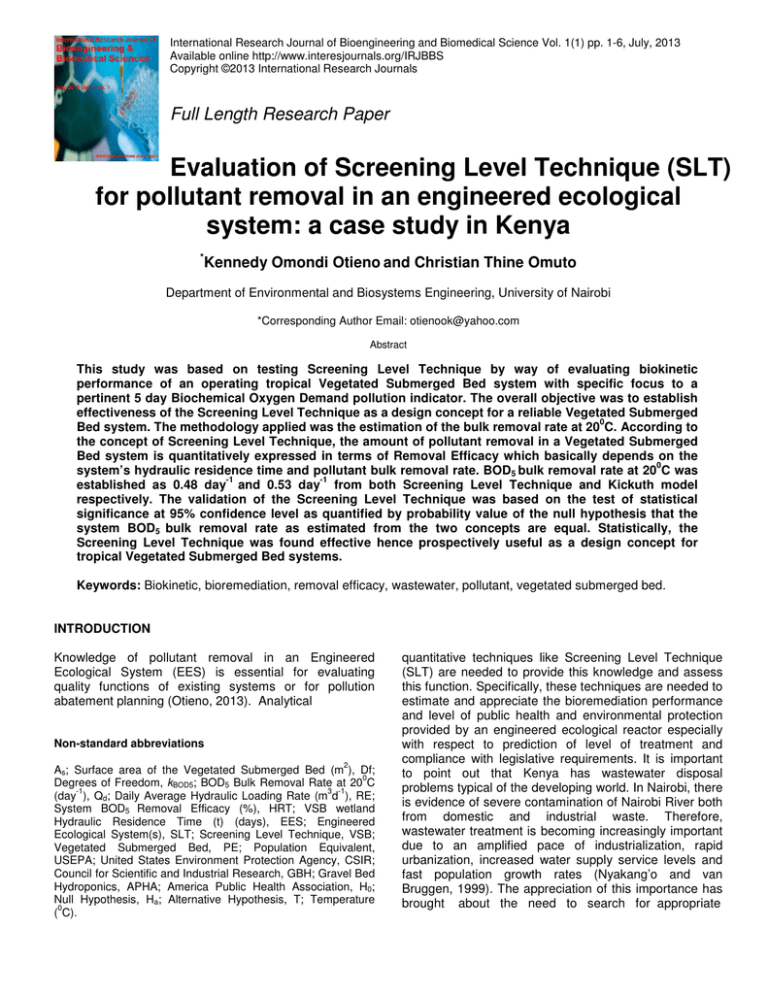
International Research Journal of Bioengineering and Biomedical Science Vol. 1(1) pp. 1-6, July, 2013 Available online http://www.interesjournals.org/IRJBBS Copyright ©2013 International Research Journals Full Length Research Paper Evaluation of Screening Level Technique (SLT) for pollutant removal in an engineered ecological system: a case study in Kenya * Kennedy Omondi Otieno and Christian Thine Omuto Department of Environmental and Biosystems Engineering, University of Nairobi *Corresponding Author Email: otienook@yahoo.com Abstract This study was based on testing Screening Level Technique by way of evaluating biokinetic performance of an operating tropical Vegetated Submerged Bed system with specific focus to a pertinent 5 day Biochemical Oxygen Demand pollution indicator. The overall objective was to establish effectiveness of the Screening Level Technique as a design concept for a reliable Vegetated Submerged 0 Bed system. The methodology applied was the estimation of the bulk removal rate at 20 C. According to the concept of Screening Level Technique, the amount of pollutant removal in a Vegetated Submerged Bed system is quantitatively expressed in terms of Removal Efficacy which basically depends on the 0 system’s hydraulic residence time and pollutant bulk removal rate. BOD5 bulk removal rate at 20 C was -1 -1 established as 0.48 day and 0.53 day from both Screening Level Technique and Kickuth model respectively. The validation of the Screening Level Technique was based on the test of statistical significance at 95% confidence level as quantified by probability value of the null hypothesis that the system BOD5 bulk removal rate as estimated from the two concepts are equal. Statistically, the Screening Level Technique was found effective hence prospectively useful as a design concept for tropical Vegetated Submerged Bed systems. Keywords: Biokinetic, bioremediation, removal efficacy, wastewater, pollutant, vegetated submerged bed. INTRODUCTION Knowledge of pollutant removal in an Engineered Ecological System (EES) is essential for evaluating quality functions of existing systems or for pollution abatement planning (Otieno, 2013). Analytical Non-standard abbreviations 2 As; Surface area of the Vegetated Submerged Bed (m ), Df; 0 Degrees of Freedom, kBOD5; BOD5 Bulk Removal Rate at 20 C -1 3 -1 (day ), Qd; Daily Average Hydraulic Loading Rate (m d ), RE; System BOD5 Removal Efficacy (%), HRT; VSB wetland Hydraulic Residence Time (t) (days), EES; Engineered Ecological System(s), SLT; Screening Level Technique, VSB; Vegetated Submerged Bed, PE; Population Equivalent, USEPA; United States Environment Protection Agency, CSIR; Council for Scientific and Industrial Research, GBH; Gravel Bed Hydroponics, APHA; America Public Health Association, H0; Null Hypothesis, Ha; Alternative Hypothesis, T; Temperature 0 ( C). quantitative techniques like Screening Level Technique (SLT) are needed to provide this knowledge and assess this function. Specifically, these techniques are needed to estimate and appreciate the bioremediation performance and level of public health and environmental protection provided by an engineered ecological reactor especially with respect to prediction of level of treatment and compliance with legislative requirements. It is important to point out that Kenya has wastewater disposal problems typical of the developing world. In Nairobi, there is evidence of severe contamination of Nairobi River both from domestic and industrial waste. Therefore, wastewater treatment is becoming increasingly important due to an amplified pace of industrialization, rapid urbanization, increased water supply service levels and fast population growth rates (Nyakang’o and van Bruggen, 1999). The appreciation of this importance has brought about the need to search for appropriate 2 Int. Res. J. Bioeng. Biomed. Sci. technology solutions suitable to local condition hence the concepts of Screening Level Technique (SLT) and Engineered Ecological Systems (EES) like Vegetated Submerged Bed (VSB) systems. Ideally, a predictive and design technique like SLT should maximize the amount of information provided while minimizing the amount of effort to obtain the information (Otieno, 2013). In other words, rather scientifically simplified and competent modeling approaches that yield useful information are highly desirable. A screening level technique refers to a simplified, quantitative, predictive model that minimizes time and effort for implementation (Dortch and Gerald, 1995). Simplification is achieved by making sound scientific assumptions that reduce complexity of the predictive mathematical formulations and input data requirements. The intent of this study was therefore based on testing effectiveness of this scientifically simplified SLT by way of applying it in evaluation of biokinetic performance of an operating Carnivore Restaurant VSB system with specific focus to 5 day Biochemical Oxygen Demand (BOD5). BOD5 was chosen because it is a pertinent indicator of organic pollution of water in biological treatment processes and generally, VSB systems are sized based on it. An Engineered Ecological System (EES) is an expertly designed and built green system where flora and fauna interact with each other and with the physical environment (Otieno, 2013). The predominant energy source in an EES is gravity, sunlight and diverse ecology. In terms of diverse ecology, EES are designed as a complex assemblage of wastewater, substrate, vegetation and an array of microorganisms (most importantly bacteria) specifically to replicate the clean up function of natural ecological systems. Vegetation forms the baseline of the ecology because besides taking up pollutants as nutrients, it offers habitat and shelter for many life forms including birds which introduce a surprising range of small organisms into an EES via feet, feathers or gut. Vegetation also helps to oxygenate water in EES systems like VSB bioreactors which in turn aids metabolism by bacteria. In the context of pollutant removal, the interactions within an Engineered Ecological System and the physical environment enable contaminants transformations into nutrients leading to decrease of toxicity of waste. Engineered Ecological Systems have been used for pollution abatement in areas such as solid waste and wastewater. The focus of this study was on the wastewater treatment Vegetated Submerged Bed (VSB) system. VSB systems (also known as Subsurface Flow Wetlands) contain a bed of media (such as crushed rock, small stones, gravel, sand or soil) vegetated with aquatic plants such as cattails and bulrushes (Vymazal, 2005). Wastewater stays beneath the surface of the media, flows in contact with the roots and rhizomes of the plants, and is not visible or available to wildlife (USEPA, 2000). VSB wetland systems are effective as wastewater treatment processes for a number of reasons. First, bacterial growth attached to the wetland gravel media and submerged roots is essential for soluble and colloidal Biochemical Oxygen Demand (BOD) reduction and other biologically driven processes. Second, the quiescent water conditions found in the subsurface media are conducive to removal of solids constituents from wastewater (Regmi et al., 2003). It should not be forgotten that an important part of the modeling process is the field evaluation of an acquired model. Once a bioremediation approach has proven effective in a laboratory or pilot scale treatability study, it must be monitored and evaluated at a field site. The objective of field phase is to demonstrate that the particular technology performs as expected in the field. This is so because for most bioremediation technologies, certain key parameters concerning applicability cannot be thoroughly evaluated until the approach is scaled and field tested on real or similar systems (USEPA, 1995). Both engineering and statistics play an important role in the verification process (USEPA, 2000). This study therefore hoped to flow along this critical path of reasoning putting emphasis on a chance for verification failure of SLT rather than a chance to pass with the intention of being insightful and useful to knowledge growth of the SLT concept as was recommended by its original developer. In so doing, the study was equally cognizant of the notion that in field verification of models, research engineers and scientists should be concerned with reliability and usefulness rather than validity (Bell and Senge, 1980; Mass and Senge, 1978). The question should be whether the model serves the purpose for which it was intended and whether it is helpful. Thus the developers and users purpose must be kept in mind in evaluating models usefulness or reliability (Otieno, 2013). Criticisms of models also should reflect this perspective. With this background, the following specific objectives were found plausible for this study. (1) To establish the biokinetic performance of an existing tropical VSB wetland system treating restaurant wastewater from a settling tank; and (2) To test the effectiveness and reliability of the SLT. MATERIALS AND METHODS Description of the System The study site is located in Nairobi, Kenya at longitude 0 0 36 48’E and latitude 1 20’S, at an altitude of 1785m in the tropics, with an average annual rainfall of 200 800mm and average minimum and maximum temperatures annual of 15.5°C and 26.5°C respectively. The wetland system was designed for a temperate climate based on 1200 Population Equivalent (PE) by CSIR (Council for Scientific and Industrial Research) in South Africa. It is a multi-stage system consisting of oil Otieno and Omuto 3 filters, pretreatment settling tanks and a Vegetated Submerged Bed (VSB) also called the subsurface 2 horizontal flow constructed wetland (area=1800m ).The VSB system was originally followed by three free surface flow wetland cells in series. The free surface flow wetland cells were later done away with to create space for other development. The Carnivore VSB similarly referred to as Gravel Bed Hydroponics (GBH) by the Carnivore staff, is simply a sunken lined walled rectangular pond filled with 1m of gravel covered with 10cm of soil to support growth of bulrush (Typha spp) and other microphytes. Alternating baffle walls are built across it at regular intervals. This theoretically ensures that water takes a serpentine flow course through the system thereby maximizing the flow distance of an element of a pollutant that consequently should increase the system’s pollutant(s) removal efficacy (Otieno, 2013). The gravel does not simply provide physical filtration of the pollutant and base for vegetation but a home for bacteria that are carefully dosed into the system at the inlet point. The planted aquatic vegetation apart from other ecological roles, principally by design, is expected to transfer oxygen from above-surface leaves to sub-surface roots. The effluent flowing through the VSB is then treated by the action of the bacteria attached to the plant roots and gravel. The aerobic bacteria are expected to be attached to the roots while the anaerobic bacteria are expected to be attached to the gravel/rocks (Otieno, 2013). Discharge from the VSB enters a level control chamber that determines the top water level within the VSB and from here it is channeled by gravity to a holding pond. Acceptance precision was defined as relative percent differences of up to 20 percent. This benchmark of 20% was informed by the reason that, at about 30% and above difference between high and low values of replicate samples; the variability is considered large and may normally indicate the presence of toxic substances or analytical problems (APHA, 1992). The study was therefore merely being careful by considering this bench mark. Description of the Screening Level Technique (SLT) As described by Dortch and Gerald (1995), a screeninglevel model is a quantitative and predictive analytical model. The model idea is to estimate Removal Efficacy (RE) for a specific pollutant given a limited amount of basic information about an EES like the VSB system. The model was built from the bottom up based on first principles. The primary scientific assumption is existence of steady state condition in EES. Also typically, two conditions are assumed for spatial gradients in concentration. That is, no existence of gradients and existence of gradients along the main flow axis. The relationship for RE, with spatial assumption of existence of longitudinal gradients or plug flow is derived from the one-dimensional mass transport equation (neglecting dispersion) and is mathematically expressed as: –K t RE = (1 – e ) x 100.............................. [1] Where; RE = system pollutant removal efficacy; 0 k = pollutant volumetric reaction rate constant at 20 C –1 (day ); and t = hydraulic residence time (days); Data collection and Laboratory Analysis Water samples for laboratory analyses were collected monthly over three months from March to May 2011. Each set of sample for a particular date was a composite of hourly grab samples taken at the VSB inlet and outlet points at an interval of 4 hours from 0800 hrs to 1600hrs. Because samples for BOD analysis may change greatly during handling and storage and since laboratory test could not be started within six hours, the samples were incubated at 4°C for not more than 48 hours of its original sampling time before beginning the BOD test. Secondary data by Nyakang’o and van Bruggen for the same VSB system taken from November 1996 to January 1997 when the system had achieved permanence status was also used. In both cases, laboratory analysis for the samples was based on the procedure outlined in Standard Method 5210B for the analysis of samples for biochemical oxygen demand (APHA, 1992). Validation of results was achieved by replicate sample analysis involving analyzing the same sample more than once and comparing the results. The closer the results were, the more accurate and precise they were considered. Validation of SLT and Estimation of BOD5 Bulk Removal Rate Validation of SLT was based on testing it against the universally accepted Kickuth model for sizing VSB 0 systems. The study used BOD5 bulk removal rate at 20 C (kBOD5) as a descriptive parameter for validation. According to Kickuth model, the basis for the design of a functional Vegetated Submerged Bed system is the surface area of the bed which basically is a function of 3 the daily average flow rate of sewage (m /d); VSB drainable porosity and water depth; daily average BOD5 substrate of the feed (mg/l) and the required average BOD5 substrate of the effluent (mg/l) with the constant being the BOD5 bulk removal rate (USEPA, 1995; UN0 HABBITAT, 2008). The BOD5 bulk removal rate at 20 C (kBOD5) according to the SLT was estimated using the following first order plug flow equation developed from equation (1) by making the pollutant volumetric reaction rate parameter the subject: kBOD5 = - ln (1- RE) / t and t = n h As / Qd................................... [2] 4 Int. Res. J. Bioeng. Biomed. Sci. Where: 0 kBOD5 = BOD5 volumetric reaction rate constant at 20 C –1 (d ); RE = system BOD5 removal efficacy (as a fraction); t = hydraulic detention time (days); n = average drainable bed porosity; h = effective wetland water depth (m); 2 As = surface area of the bed (m ); and 3 Qd = daily average hydraulic loading rate (m /d). An average system drainable porosity of 36% was considered (Reed et al., 1995; Otieno, 2013). The t-test statistics was used to test statistical significance (5% significant level), as quantified by probability (p-value), of the null hypothesis that the means of the bulk removal rate parameter as estimated from the two equations are equal (Kothari, 2004). RESULTS The Carnivore VSB wetland system received from November 1996 to January 1997 and March 2011 to May 3 2011 an average of 97m wastewater/day. In table 1, an overview is given of the inflow and outflow wastewater characteristics of the Carnivore VSB. As can be seen, BOD5 showed a rapid decrease from an inflow concentration average of 610mg/l to an outflow concentration average of 34mg/l. The results indicate a positive treatment result by Carnivore Restaurant VSB system. Based on the data, the average bulk loss value from both the Kickuth model and screening level -1 technique were computed and established as 0.53d and -1 0.48d respectively. The data for the test of statistical significance (5% significant level), as quantified by probability (p-value), of the null hypothesis that the means of the BOD5 bulk removal rate parameter as estimated from the two equations are equal is presented in table 2. DISCUSSIONS The influent wastewater into the Carnivore VSB system with mean BOD5 concentrations of 610 mg/l falls under the class of strong sewage (Mara, 1986; Metcalf et al., 2003). This could be attributed to low specific water consumption of about 80 litres per Population Equivalent (PE) daily (150 litres per PE daily is normally expected) assuming a total design PE served of 1200 for the 3 estimated wastewater production rate of 97m /day. Figure 1 illustrates the expected biokinetic performance of the Carnivore VSB system. The illustrated performance is based on a high bioremediation performance of 96% achieved despite system surface overflow caused by clogging of the void spaces of the gravel substrate in the about 35% entry zone. Generally and while noting that this study is expected to continue, the preliminary finding is that the BOD5 reduction performance for the Carnivore VSB system can be said to be good for the reason that what is agreeably expected is about 80% performance (Adrian and Frank, 2004). However, the Carnivore system performs nonconventionally in the overall biokinetic expectation since -1 the evaluated BOD5 bulk loss value of 0.48 day could -1 only compare favourably to that of 0.50 day for conventional free surface flow wetlands as opposed to -1 the characteristic value of 1.104d for conventional VSB systems. Thus usage of gravel as a substrate in the Carnivore VSB system did not add any technical value. The nonstandard performance of the Carnivore VSB system could not be associated with the probable ineffectiveness on the part of the SLT but rather other factors outside the scope of the study such as reactor incomplete kinetics due to short circuiting of pollutants travel path brought by system blockages and hydraulic design deficiencies. For example and as can be seen from figure 1, the system achieved an agreeably expected 80% BOD5 reduction performance mark in less than four days which possibly point to the fact that the system could have been oversized in terms of longer hydraulic residence time (HRT). The longer HRT perhaps had a negative influence on the biokinetic performance of the Carnivore VSB reactor. This is because VSB biokinetic performance has a sensitive relationship with the residence time an element of a pollutant takes in a VSB reactor. After HRT of more than two days, the reduction of BOD5 is not strongly dependent on HRT since removal improves only slightly thereafter up to HRT of 7.5 days (USEPA, 1995). Therefore, overdesign far beyond the critical two day HRT increases biochemical oxygen demand given that larger biodegradable particles that have been quickly removed by physical mechanism will be degraded over time and be converted into particles in the soluble and small colloidal size range. As such they become an internal source of BOD as they degrade and reenter the water. Some material is also incorporated into microbial biomass. True BOD removal only occurs when the material causing the BOD is completely converted by anaerobic biological processes to gaseous end products and this is expected to take place within the first two days for a conventional VSB system. The other significant reason Screening Level Technique as a design and predictive model could not be associated with the Carnivore nonstandard performance is that it was subjected to risk of verification of failure by field testing its effectiveness and prospective usefulness against the universally accepted Kickuth model. Statistically, it could not be invalidated by the finding of the preliminary study. This implies that the SLT is prospectively useful as a design concept for functional wastewater VSB bioremediation systems in Kenya. Thus, it could in future be applied in confidence in the screening level assessment of biokinetic performance of existing Otieno and Omuto 5 Table 1. Summary of performance data for Carnivore VSB system 3 Date Nov-96 Dec-96 Jan-97 Mar-11 Apr-11 May-11 Average Daily Flow (m /day) Inflow Outflow 94 74 123 98 70 29 85 60 106 78 103 70 97 68 BOD5 (mg/l) Inflow Outflow 550 40 600 20 750 50 620 25 560 38 580 32 610 34 Table 2. Hypothesis Test Data H0: µ = µ0 = Ha : µ ≠ µ0 = (α) Sample size (n) Degree of freedom (Df) Sample mean (µ) Hypothesized mean (µ0) Sample standard deviation (σs) Calculated test statistic (t) Critical t-value Conclusion -1 0.53 d -1 0.53 d 0.05 6 5 -1 0.48 d -1 0.53 d -1 0.1021 d -1.200 -2.571 Do not reject H0 Figure 1. Expected Biokinetic Performance for the Carnivore VSB Reactor 6 Int. Res. J. Bioeng. Biomed. Sci. engineered ecological systems. It should be taken in consideration that fundamental scientific knowledge of the processes of pollutants removal in VSB bioremediation systems is highly limited at present in Kenya. The current design process for VSB systems is also still largely based upon observational data rather than scientific theories. The observational approach to the design of VSB systems has led to the implementation of many uneconomical non-performing systems. This has in the past contributed to the problem of continued pollution of fresh water sources and compromise of the aquatic environment. This study is therefore expected to make a positive contribution. ACKNOWLEDGEMENTS Acknowledgment is extended to the University of Nairobi School of engineering staff and the Carnivore Restaurant staff for the support during the period of this study. We also extend acknowledgment to the various authors whose publications have been cited. Specifically, we are indebted to Nyakang’o and van Bruggen whose previous work at the same case study formed an integral part of the data used in this study. REFERENCES Adrian TH, Frank PE (2004). Constructed wetlands: A critical review of wetland treatment processes. Department of Civil and Environmental Engineering office of curriculum development, New Mexico State University APHA (1992). Standard methods for the examination of water and wastewater. America Public Health Association, Washington DC Bell JA, Senge PM (1980). Enhancing refutability. In: Legasto, A.A. Jr.; Forrester, M.W.; and Lyneis, T.M., eds. System Dynamics. New York: Elsevier North- Holland, pp. 61-73. Dortch MS, Gerald JA (1995). Screening-level model for estimating pollutant removal by wetlands, Technical Report WQ-EV-2.1, U.S. Army Engineer Waterways Experiment Station, Vicksburg, MS Kothari CR (2OO4). Research Methodology: Methods and Techniques. New age international (p) limited, publishers.4835/24, New Delhi110002. Mara DD (1986). Sewage treatment in hot climates. John Wiley and Sons Ltd, Chichester, West Sussex, U.K Mass NJ, Senge PM (1978). Alternative tests for the selection of model variables. IEE Systems, Man and Cybernetics, 8 (6):450—459. Metcalf and Eddy Inc (2003). Wastewater Engineering: Treatment, Disposal and Reuse. New York, NY: McGraw-Hill. Nyakang’o JB, van Bruggen JJA (1999). Combination of a well functioning constructed wetland with a pleasing landscape in Nairobi Kenya. Water Science Technology volume 40(3): 249-256 Otieno OK (2O13). Evaluation of Screening Level Technique in Pollutant Removal in an Engineered Ecological System. A thesis submitted to the University of Nairobi for the degree of M.Sc in Environmental Engineering. Reed SC, Crites RW, Middlebrooks JE (1995). Natural Systems for Waste Management and Treatment. Second edition. McGraw-Hill, Inc., New York Regmi TP, Thompson AL, Sievers DM (2003). Comparative Studies of Vegetated and Non-Vegetated Submerged flow Wetlands Treating Primary Lagoon Effluent. Am. Society of Agric. Engineers J. 46(1):1727. UN-HABITAT (2008). Constructed Wetlands Manual. UN-HABITAT Water for Asian Cities Programme Nepal, Kathmandu. 978-92-1131963-7 USEPA (1993). Subsurface Flow Constructed Wetlands for Wastewater Treatment: A Technology Assessment. S.C. Reed, ed., EPA/ 832/R93/008. US EPA Office of Water, Washington, D.C USEPA (1995). Bioremediation of hazard wastes. Research, development and field evaluations. EPA/540/R-95/532. US EPA Office of Research and Development, Washington DC USEPA (2000). Manual: Constructed Wetlands Treatment of Municipal Wastewaters. EPA/625/R-99/010. US EPA Office of Research and Development, Cincinnati, OH Vymazal J (2005). Horizontal sub-surface flow and hybrid constructed wetland systems for wastewater treatment. Ecological Engineering 25(2005):478-490.
